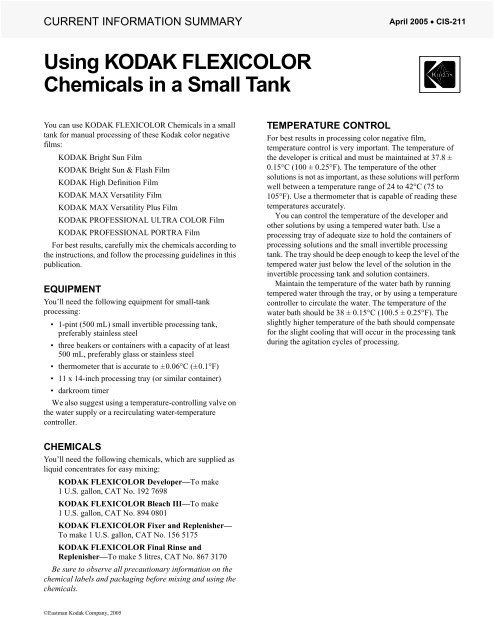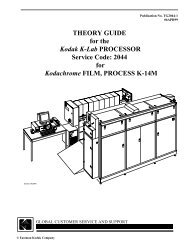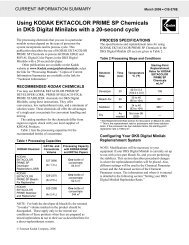Using KODAK FLEXICOLOR Chemicals in a Small Tank - 125px
Using KODAK FLEXICOLOR Chemicals in a Small Tank - 125px
Using KODAK FLEXICOLOR Chemicals in a Small Tank - 125px
You also want an ePaper? Increase the reach of your titles
YUMPU automatically turns print PDFs into web optimized ePapers that Google loves.
CURRENT INFORMATION SUMMARY<br />
<strong>Us<strong>in</strong>g</strong> <strong>KODAK</strong> <strong>FLEXICOLOR</strong><br />
<strong>Chemicals</strong> <strong>in</strong> a <strong>Small</strong> <strong>Tank</strong><br />
You can use <strong>KODAK</strong> <strong>FLEXICOLOR</strong> <strong>Chemicals</strong> <strong>in</strong> a small<br />
tank for manual process<strong>in</strong>g of these Kodak color negative<br />
films:<br />
<strong>KODAK</strong> Bright Sun Film<br />
<strong>KODAK</strong> Bright Sun & Flash Film<br />
<strong>KODAK</strong> High Def<strong>in</strong>ition Film<br />
<strong>KODAK</strong> MAX Versatility Film<br />
<strong>KODAK</strong> MAX Versatility Plus Film<br />
<strong>KODAK</strong> PROFESSIONAL ULTRA COLOR Film<br />
<strong>KODAK</strong> PROFESSIONAL PORTRA Film<br />
For best results, carefully mix the chemicals accord<strong>in</strong>g to<br />
the <strong>in</strong>structions, and follow the process<strong>in</strong>g guidel<strong>in</strong>es <strong>in</strong> this<br />
publication.<br />
EQUIPMENT<br />
You’ll need the follow<strong>in</strong>g equipment for small-tank<br />
process<strong>in</strong>g:<br />
1-p<strong>in</strong>t (500 mL) small <strong>in</strong>vertible process<strong>in</strong>g tank,<br />
preferably sta<strong>in</strong>less steel<br />
three beakers or conta<strong>in</strong>ers with a capacity of at least<br />
500 mL, preferably glass or sta<strong>in</strong>less steel<br />
thermometer that is accurate to ± 0.06°C (± 0.1°F)<br />
11 x 14-<strong>in</strong>ch process<strong>in</strong>g tray (or similar conta<strong>in</strong>er)<br />
darkroom timer<br />
We also suggest us<strong>in</strong>g a temperature-controll<strong>in</strong>g valve on<br />
the water supply or a recirculat<strong>in</strong>g water-temperature<br />
controller.<br />
CHEMICALS<br />
You’ll need the follow<strong>in</strong>g chemicals, which are supplied as<br />
liquid concentrates for easy mix<strong>in</strong>g:<br />
<strong>KODAK</strong> <strong>FLEXICOLOR</strong> Developer—To make<br />
1 U.S. gallon, CAT No. 192 7698<br />
<strong>KODAK</strong> <strong>FLEXICOLOR</strong> Bleach III—To make<br />
1 U.S. gallon, CAT No. 894 0801<br />
<strong>KODAK</strong> <strong>FLEXICOLOR</strong> Fixer and Replenisher—<br />
To make 1 U.S. gallon, CAT No. 156 5175<br />
<strong>KODAK</strong> <strong>FLEXICOLOR</strong> F<strong>in</strong>al R<strong>in</strong>se and<br />
Replenisher—To make 5 litres, CAT No. 867 3170<br />
Be sure to observe all precautionary <strong>in</strong>formation on the<br />
chemical labels and packag<strong>in</strong>g before mix<strong>in</strong>g and us<strong>in</strong>g the<br />
chemicals.<br />
©Eastman Kodak Company, 2005<br />
April 2005 • CIS-211<br />
TEMPERATURE CONTROL<br />
For best results <strong>in</strong> process<strong>in</strong>g color negative film,<br />
temperature control is very important. The temperature of<br />
the developer is critical and must be ma<strong>in</strong>ta<strong>in</strong>ed at 37.8 ±<br />
0.15°C (100 ± 0.25°F). The temperature of the other<br />
solutions is not as important, as these solutions will perform<br />
well between a temperature range of 24 to 42°C (75 to<br />
105°F). Use a thermometer that is capable of read<strong>in</strong>g these<br />
temperatures accurately.<br />
You can control the temperature of the developer and<br />
other solutions by us<strong>in</strong>g a tempered water bath. Use a<br />
process<strong>in</strong>g tray of adequate size to hold the conta<strong>in</strong>ers of<br />
process<strong>in</strong>g solutions and the small <strong>in</strong>vertible process<strong>in</strong>g<br />
tank. The tray should be deep enough to keep the level of the<br />
tempered water just below the level of the solution <strong>in</strong> the<br />
<strong>in</strong>vertible process<strong>in</strong>g tank and solution conta<strong>in</strong>ers.<br />
Ma<strong>in</strong>ta<strong>in</strong> the temperature of the water bath by runn<strong>in</strong>g<br />
tempered water through the tray, or by us<strong>in</strong>g a temperature<br />
controller to circulate the water. The temperature of the<br />
water bath should be 38 ± 0.15°C (100.5 ± 0.25°F). The<br />
slightly higher temperature of the bath should compensate<br />
for the slight cool<strong>in</strong>g that will occur <strong>in</strong> the process<strong>in</strong>g tank<br />
dur<strong>in</strong>g the agitation cycles of process<strong>in</strong>g.
PROCESSING<br />
After mix<strong>in</strong>g the process<strong>in</strong>g chemicals accord<strong>in</strong>g to<br />
directions, take the cover off the small <strong>in</strong>vertible process<strong>in</strong>g<br />
tank and add enough developer so that the tank will be<br />
completely full with the process<strong>in</strong>g reel(s) added. Place the<br />
process<strong>in</strong>g tank <strong>in</strong> the tempered water bath and allow<br />
enough time for the developer to reach the temperature of<br />
the water bath. Pour the other solutions <strong>in</strong>to<br />
appropriate-sized beakers or conta<strong>in</strong>ers. If the temperature<br />
<strong>in</strong> the darkroom is not adequate to keep the bleach, fix, and<br />
r<strong>in</strong>se solutions at the appropriate temperature, you may f<strong>in</strong>d<br />
it convenient to add these conta<strong>in</strong>ers to the tempered water<br />
bath.<br />
F002_1218BC<br />
Process<strong>in</strong>g Steps and Conditions<br />
Solution/Step<br />
Time<br />
(m<strong>in</strong>:sec)<br />
Developer 3:15<br />
Bleach 6:30<br />
Wash 1:30<br />
Fixer 6:30<br />
Wash 3:15<br />
F<strong>in</strong>al R<strong>in</strong>se 1:30<br />
Dry As needed<br />
Temperature<br />
°C (°F)<br />
37.8 ± 0.15<br />
(100 ± 0.25)<br />
24 to 41<br />
(75 to 105)<br />
24 to 41<br />
(75 to 105)<br />
24 to 41<br />
(75 to 105)<br />
24 to 41<br />
(75 to 105)<br />
24 to 41<br />
(75 to 105)<br />
24 to 43<br />
(75 to 110)<br />
In complete darkness, load the film onto the process<strong>in</strong>g<br />
reel(s), then place the loaded reel(s) <strong>in</strong>to the small<br />
<strong>in</strong>vertible process<strong>in</strong>g tank. Quickly start the darkroom<br />
timer and place the cover on the process<strong>in</strong>g tank, and beg<strong>in</strong><br />
<strong>in</strong>itial agitation.<br />
Note: If the small <strong>in</strong>vertible process<strong>in</strong>g tank is lighttight,<br />
you can turn the lights on at this po<strong>in</strong>t. Otherwise, leave the<br />
lights off until after the bleach step is completed then turn<br />
the lights on.<br />
Follow the process<strong>in</strong>g and agitation procedures <strong>in</strong> the<br />
table below. Agitate the tank by turn<strong>in</strong>g the tank over<br />
(<strong>in</strong>vert<strong>in</strong>g it) with a slight rotation (quarter turn), then<br />
return the tank to an upright position. Do this at a rate of<br />
one agitation cycle per second.<br />
Comments<br />
Initial agitation for 30 seconds, followed by 2 seconds of agitation every<br />
15 seconds. Use last 10 seconds of this step to dra<strong>in</strong> tank.<br />
Initial agitation for 30 seconds, followed by 5 seconds of agitation every<br />
30 seconds. Use last 10 seconds of this step to dra<strong>in</strong> tank.<br />
Use runn<strong>in</strong>g-water wash at rate that will fill tank every 4 seconds. Or fill<br />
tank with water, agitate for 5 seconds, and dump. Repeat cycle throughout<br />
wash time. Use last 10 seconds of this step to dra<strong>in</strong> tank.<br />
Initial agitation for 30 seconds, followed by 5 seconds of agitation every<br />
30 seconds. Use last 10 seconds of this step to dra<strong>in</strong> tank.<br />
Repeat procedure used for first wash.<br />
Initial agitation for 30 seconds; no further agitation required.<br />
Remove film from reel, and hang film to dry <strong>in</strong> dust-free place or dry<strong>in</strong>g<br />
cab<strong>in</strong>et. Attach film clip to top to hang it, and add weighted clip to bottom to<br />
prevent curl.<br />
2 <strong>Us<strong>in</strong>g</strong> <strong>KODAK</strong> <strong>FLEXICOLOR</strong> <strong>Chemicals</strong> <strong>in</strong> a <strong>Small</strong> <strong>Tank</strong> • CIS-211
Push-Process<strong>in</strong>g <strong>KODAK</strong> PROFESSIONAL<br />
ULTRA COLOR and PORTRA Films<br />
<strong>KODAK</strong> PROFESSIONAL ULTRA COLOR 400UC and<br />
PORTRA 800 Films are designed so that you can<br />
push-process them to higher exposure <strong>in</strong>dexes. You can<br />
push-process ULTRA COLOR 400UC Film to an exposure<br />
<strong>in</strong>dex of 800, and PORTRA 800 Film to exposure <strong>in</strong>dexes of<br />
1600 and 3200, and produce negatives that yield<br />
good-quality pr<strong>in</strong>ts.<br />
To push-process these films, extend the developer time<br />
accord<strong>in</strong>g to the table below. Keep all other process times the<br />
same as those for a normal process.<br />
Exposure Index<br />
Development Time<br />
(m<strong>in</strong>:sec)<br />
ULTRA COLOR 400UC Film<br />
EI 400 3:15<br />
EI 800 (Push 1)<br />
PORTRA 800 Film<br />
3:45<br />
EI 800 3:15<br />
EI 1600 (Push 1) 3:45<br />
EI 3200 (Push 2) 4:15<br />
CAPACITY OF SOLUTIONS<br />
Do not reuse the developer. Use the developer for one<br />
process cycle, and then discard it. You can use the bleach,<br />
fixer, and f<strong>in</strong>al r<strong>in</strong>se once, or save and reuse them until the<br />
solution capacities are reached. Use the table below to<br />
calculate the capacity of the bleach, fixer, and f<strong>in</strong>al r<strong>in</strong>se<br />
only.<br />
Film Size<br />
Bleach, Fixer, or F<strong>in</strong>al R<strong>in</strong>se<br />
Capacity<br />
per Quart/Litre<br />
110-24 25 cartridges<br />
135-12 20 rolls<br />
135-24 12 rolls<br />
135-36 10 rolls<br />
120 10 rolls<br />
STORAGE OF SOLUTIONS<br />
Store unmixed chemical concentrates <strong>in</strong> a dry location at a<br />
temperature of 5 to 30°C (0 to 86°F). Lower temperatures<br />
may cause components to come out of solution or crystallize.<br />
Higher temperatures can accelerate chemical reactions and<br />
cause deterioration of chemical components.<br />
Store mixed solutions <strong>in</strong> tightly sealed bottles—<br />
preferably full, tightly stoppered glass bottles. For best<br />
results, do not use mixed solutions that have been stored<br />
longer than the follow<strong>in</strong>g times:<br />
Storage Time <strong>in</strong> Full,<br />
Mixed Solution Tightly Stoppered<br />
Bottles<br />
Developer 6 weeks<br />
Bleach, Fixer,<br />
8 weeks<br />
F<strong>in</strong>al R<strong>in</strong>se<br />
<strong>Us<strong>in</strong>g</strong> <strong>KODAK</strong> <strong>FLEXICOLOR</strong> <strong>Chemicals</strong> <strong>in</strong> a <strong>Small</strong> <strong>Tank</strong> • CIS-211 3
<strong>Us<strong>in</strong>g</strong> <strong>KODAK</strong> <strong>FLEXICOLOR</strong> <strong>Chemicals</strong> <strong>in</strong> a <strong>Small</strong> <strong>Tank</strong><br />
SAFE HANDLING OF <strong>KODAK</strong><br />
PROCESSING CHEMICALS<br />
<strong>Chemicals</strong> are safe when handled properly. That's why it's<br />
important to know and understand the chemicals you're<br />
work<strong>in</strong>g with and the appropriate protective measures you<br />
should use when handl<strong>in</strong>g them. To safely handle<br />
photographic process<strong>in</strong>g chemicals, follow these guidel<strong>in</strong>es:<br />
Always read and observe recommendations on the<br />
product labels and the Material Safety Data Sheets<br />
(MSDS) before mix<strong>in</strong>g and us<strong>in</strong>g the chemicals. MSDS<br />
sheets can be obta<strong>in</strong>ed on-l<strong>in</strong>e at<br />
www.kodak.com/go/msds.<br />
When handl<strong>in</strong>g chemicals, avoid any sk<strong>in</strong> and eye<br />
contact. Wear protective cloth<strong>in</strong>g to ensure your safety<br />
such as:<br />
– Neoprene or nitrile gloves, to prevent contact with<br />
sk<strong>in</strong><br />
– Safety glasses with side shields or goggles, to prevent<br />
chemicals from gett<strong>in</strong>g <strong>in</strong>to your eyes<br />
– V<strong>in</strong>yl or rubber apron or lab coat, to prevent<br />
chemicals from com<strong>in</strong>g <strong>in</strong> contact with your cloth<strong>in</strong>g<br />
Do not eat, dr<strong>in</strong>k, or smoke <strong>in</strong> chemical handl<strong>in</strong>g areas.<br />
To avoid build-up of air co ntam<strong>in</strong>ants associated with<br />
process<strong>in</strong>g chemicals, provide adequate ventilation <strong>in</strong><br />
chemical handl<strong>in</strong>g areas. <strong>Us<strong>in</strong>g</strong> a room with a source of<br />
fresh air is recommended. As a guidel<strong>in</strong>e, the ventilation<br />
required should change the entire volume of air <strong>in</strong> the<br />
area 5 times per hour. In some cases, locally vent<strong>in</strong>g the<br />
chemical work area to the outdoors may be appropriate<br />
to prevent excess humidity and odors <strong>in</strong> the chemical<br />
handl<strong>in</strong>g areas.<br />
Properly dispose of photographic process<strong>in</strong>g chemicals<br />
<strong>in</strong> accordance with local sewer discharge regulations.<br />
Kodak does not recommend the use of septic systems for<br />
disposal of photographic process<strong>in</strong>g chemicals.<br />
For <strong>in</strong>formation on darkroom design, see the follow<strong>in</strong>g<br />
publication on www.kodak.com/go/professional<br />
– AK-3, Darkroom Design for Amateur Photographers<br />
For more <strong>in</strong>formation, see the follow<strong>in</strong>g <strong>KODAK</strong><br />
Publications on www.kodak.com/go/kes<br />
– J-98A, Safe Handl<strong>in</strong>g of Photographic Process<strong>in</strong>g<br />
<strong>Chemicals</strong><br />
– J-300, Environmental Guidel<strong>in</strong>es for Amateur<br />
Photographers<br />
– J-314, Indoor Air Quality and Ventilation <strong>in</strong><br />
Photographic Process<strong>in</strong>g Facilities<br />
<strong>Us<strong>in</strong>g</strong> <strong>KODAK</strong> <strong>FLEXICOLOR</strong><br />
<strong>Chemicals</strong> <strong>in</strong> a <strong>Small</strong> <strong>Tank</strong><br />
<strong>KODAK</strong> Publication No. CIS-211<br />
MORE INFORMATION<br />
Kodak has many publications to assist you with <strong>in</strong>formation on<br />
Kodak products, equipment, and materials.<br />
For the latest version of technical support publications for<br />
<strong>KODAK</strong> Products, visit Kodak on-l<strong>in</strong>e at:<br />
www.kodak.com<br />
If you have questions about <strong>KODAK</strong> Products, call Kodak.<br />
In the U.S.A.:<br />
1-800-242-2424, Monday–Friday<br />
9 a.m.–7 p.m. (Eastern time)<br />
In Canada:<br />
1-800-465-6325, Monday–Friday<br />
8 a.m.–5 p.m. (Eastern time)<br />
Digital & Film Imag<strong>in</strong>g Systems<br />
EASTMAN <strong>KODAK</strong> COMPANY • ROCHESTER, NY 14650<br />
Kodak, Kodak Professional, Flexicolor, Max, Portra, and Ultra Color are trademarks.<br />
M<strong>in</strong>or Revision 4-05

















